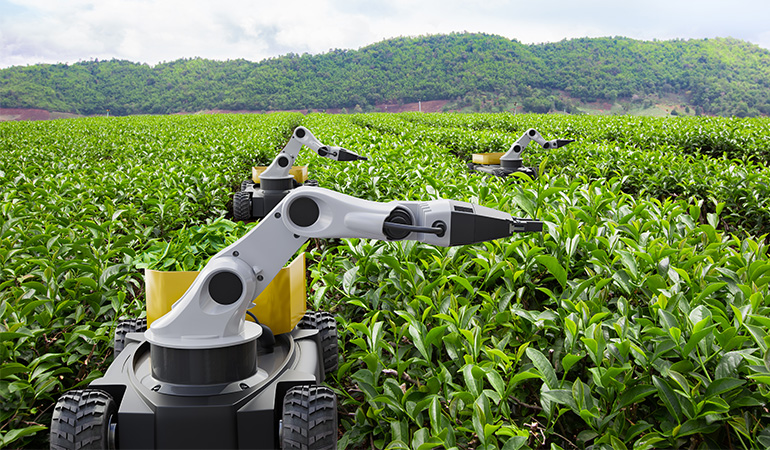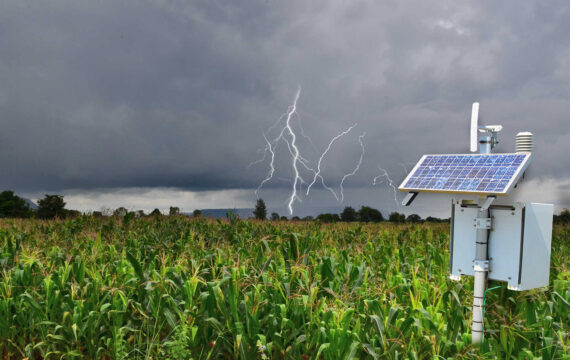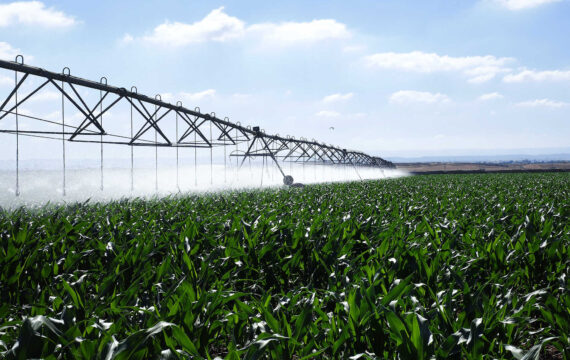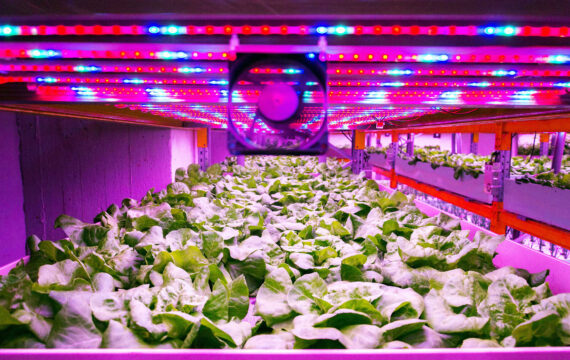The growth of the global population, which is projected to reach 10 billion by 2050, is placing significant pressure on the agricultural sector to increase crop production and maximize yields. To address looming food shortages, two potential approaches have emerged: expanding land use and adopting large-scale farming, or embracing innovative practices and leveraging technological advancements to enhance productivity on existing farmland
Pushed by many obstacles to achieving desired farming productivity — limited land holdings, labor shortages, climate change, environmental issues, and diminishing soil fertility, to name a few, — the modern agricultural landscape is evolving, branching out in various innovative directions. Farming has certainly come a long way since hand plows or horse-drawn machinery. Each season brings new technologies designed to improve efficiency and capitalize on the harvest. However, both individual farmers and global agribusinesses often miss out on the opportunities that artificial intelligence in agriculture can offer to their farming methods.
At Intellias, we’ve worked with the agricultural sector for over 20 years, successfully implementing real-life technological solutions. Our focus has been on developing innovative systems for quality control, traceability, compliance practices, and more. Now, we will dive deeper into how new technologies can help your farming business move forward.
Benefits of AI in agriculture
Until recently, using the words AI and agriculture in the same sentence may have seemed like a strange combination. After all, agriculture has been the backbone of human civilization for millennia, providing sustenance as well as contributing to economic development, while even the most primitive AI only emerged several decades ago. Nevertheless, innovative ideas are being introduced in every industry, and agriculture is no exception. In recent years, the world has witnessed rapid advancements in agricultural technology, revolutionizing farming practices. These innovations are becoming increasingly essential as global challenges such as climate change, population growth together with resource scarcity threaten the sustainability of our food system. Introducing AI solves many challenges and helps to diminish many disadvantages of traditional farming.
Data-based decisions
The modern world is all about data. Organizations in the agricultural sector use data to obtain meticulous insights into every detail of the farming process, from understanding each acre of a field to monitoring the entire produce supply chain to gaining deep inputs on yields generation process. AI-powered predictive analytics is already paving the way into agribusinesses. Farmers can gather, then process more data in less time with AI. Additionally, AI can analyze market demand, forecast prices as well as determine optimal times for sowing and harvesting.
Artificial intelligence in agriculture can help explore the soil health to collect insights, monitor weather conditions, and recommend the application of fertilizer and pesticides. Farm management software boosts production together with profitability, enabling farmers to make better decisions at every stage of the crop cultivation process.
Cost savings
Improving farm yields is a constant goal for farmers. Combined with AI, precision agriculture can help farmers grow more crops with fewer resources. AI in farming combines the best soil management practices, variable rate technology, and the most effective data management practices to maximize yields while minimizing minimize spending.
Application of AI in agriculture provides farmers with real-time crop insights, helping them to identify which areas need irrigation, fertilization, or pesticide treatment. Innovative farming practices such as vertical agriculture can also increase food production while minimizing resource usage. Resulting in reduced use of herbicides, better harvest quality, higher profits alongside significant cost savings.
Automation impact
Agricultural work is hard, so labor shortages are nothing new. Thankfully, automation provides a solution without the need to hire more people. While mechanization transformed agricultural activities that demanded super-human sweat and draft animal labor into jobs that took just a few hours, a new wave of digital automation is once more revolutionizing the sector.
Automated farm machinery like driverless tractors, smart irrigation, fertilization systems, IoT-powered agricultural drones, smart spraying, vertical farming software, and AI-based greenhouse robots for harvesting are just some examples. Compared with any human farm worker, AI-driven tools are far more efficient and accurate.
Applications of artificial intelligence in agriculture
The AI in agriculture market is expected to grow from USD 1.7 billion in 2023 to USD 4.7 billion by 2028, according to MarketsandMarkets.
Traditional farming involves various manual processes. Implementing AI models can have many advantages in this respect. By complementing already adopted technologies, an intelligent agriculture system can facilitate many tasks. AI can collect and process big data, while determining and initiating the best course of action. Here are some common use cases for AI in agriculture:
Optimizing automated irrigation systems
AI algorithms enable autonomous crop management. When combined with IoT (Internet of Things) sensors that monitor soil moisture levels and weather conditions, algorithms can decide in real-time how much water to provide to crops. An autonomous crop irrigation system is designed to conserve water while promoting sustainable agriculture and farming practices. AI in smart greenhouses optimizes plant growth by automatically adjusting temperature, humidity, and light levels based on real-time data.

Detecting leaks or damage to irrigation systems
AI plays a crucial role in detecting leaks in irrigation systems. By analyzing data, algorithms can identify patterns and anomalies that indicate potential leaks. Machine learning (ML) models can be trained to recognize specific signatures of leaks, such as changes in water flow or pressure. Real-time monitoring and analysis enable early detection, preventing water waste together with potential crop damage.
AI also incorporates weather data alongside crop water requirements to identify areas with excessive water usage. By automating leak detection and providing alerts, AI technology enhances water efficiency helping farmers conserve resources.
Crop and soil monitoring
The wrong combination of nutrients in soil can seriously affect the health and growth of crops. Identifying these nutrients and determining their effects on crop yield with AI allows farmers to easily make the necessary adjustments.
While human observation is limited in its accuracy, computer vision models can monitor soil conditions to gather accurate data necessary for combatting crop diseases. This plant science data is then used to determine crop health, predict yields while flagging any particular issues. Plants start AI systems through sensors that detect their growth conditions, triggering automated adjustments to the environment.
Read also: Top Applications of Computer Vision
In practice, AI in agriculture and farming has been able to accurately track the stages of wheat growth and the ripeness of tomatoes with a degree of speed and accuracy no human can match.

Detecting disease and pests
As well as detecting soil quality and crop growth, computer vision can detect the presence of pests or diseases. This works by using AI in agriculture projects to scan images to find mold, rot, insects, or other threats to crop health. In conjunction with alert systems, this helps farmers to act quickly in order to exterminate pests or isolate crops to prevent the spread of disease.
AI technology in agriculture has been used to detect apple black rot with an accuracy of over 90%. It can also identify insects like flies, bees, moths, etc., with the same degree of accuracy. However, researchers first needed to collect images of these insects to have the necessary size of the training data set to train the algorithm with.
Monitoring livestock health
It may seem easier to detect health problems in livestock than in crops, in fact, it’s particularly challenging. Thankfully, AI for farming can help with this. For example, a company called CattleEye has developed a solution that uses drones, cameras together with computer vision to monitor cattle health remotely. It detects atypical cattle behavior and identifies activities such as birthing.
CattleEye uses AI and ML solutions to determine the impact of diet alongside environmental conditions on livestock and provide valuable insights. This knowledge can help farmers improve the well-being of cattle to increase milk production.

Intelligent pesticide application
By now, farmers are well aware that the application of pesticides is ripe for optimization. Unfortunately, both manual and automated application processes have notable limitations. Applying pesticides manually offers increased precision in targeting specific areas, though it might be slow and difficult work. Automated pesticide spraying is quicker and less labor-intensive, but often lacks accuracy leading to environment contamination.
AI-powered drones provide the best advantages of each approach while avoiding their drawbacks. Drones use computer vision to determine the amount of pesticide to be sprayed on each area. While still in infancy, this technology is rapidly becoming more precise.

Yield mapping and predictive analytics
Yield mapping uses ML algorithms to analyze large datasets in real time. This helps farmers understand the patterns and characteristics of their crops, allowing for better planning. By combining techniques like 3D mapping, data from sensors and drones, farmers can predict soil yields for specific crops. Data is collected on multiple drone flights, enabling increasingly precise analysis with the use of algorithms.
These methods permit the accurate prediction of future yields for specific crops, helping farmers know where and when to sow seeds as well as how to allocate resources for the best return on investment.
Automatic weeding and harvesting
Similar to how computer vision can detect pests and diseases, it can also be used to detect weeds and invasive plant species. When combined with machine learning, computer vision analyzes the size, shape, and color of leaves to distinguish weeds from crops. Such solutions can be used to program robots that carry out robotic process automation (RPA) tasks, such as automatic weeding. In fact, such a robot has already been used effectively. As these technologies become more accessible, both weeding and harvesting crops could be carried out entirely by smart bots.
Sorting harvested produce
AI is not only useful for identifying potential issues with crops while they’re growing. It also has a role to play after produce has been harvested. Most sorting processes are traditionally carried out manually however AI can sort produce more accurately.
Computer vision can detect pests as well as disease in harvested crops. What’s more, it can grade produce based on its shape, size, and color. This enables farmers to quickly separate produce into categories — for example, to sell to different customers at different prices. In comparison, traditional manual sorting methods can be painstakingly labor-intensive.

Surveillance
Security is an important part of farm management. Farms are common targets for burglars, as it’s hard for farmers to monitor their fields around the clock. Animals are another threat — whether it’s foxes breaking into the chicken coop or a farmer’s own livestock damaging crops or equipment. When combined with video surveillance systems, computer vision and ML can quickly identify security breaches. Some systems are even advanced enough to distinguish employees from unauthorized visitors.
Role of AI in the agriculture information management cycle
Managing agricultural data with AI can be beneficial in many ways:
Risk management
Predictive analytics reduces errors in farming processes.
Plant breeding
AI utilized plant growth data to further advise on crops that are more resilient to extreme weather, disease or harmful pests.
Soil and crop health analysis
AI algorithms can analyze the chemical composition of soil samples to determine which nutrients may be lacking. AI can also identify or even predict crop diseases.
Crop feeding
AI in irrigation is useful for identifying optimal patterns and nutrient application times, while predicting the optimal mix of agronomic products.
Harvesting
AI is useful for enhancing crop yields and can even predict the best time to harvest crops.
Optimizing AI for agriculture and agricultural processes
While the benefits of AI in agriculture are vivid, it can’t function without other digital technologies already in place such as big data, sensors, and software. Likewise, other technologies need AI for them to work properly. In the case of big data, the data itself is not particularly useful. What matters is how it’s processed and implemented.
Big data for informed decision-making
Combining AI with big data analytics allows farmers to get recommendations based on accurate, real-time information, thereby increasing productivity hence reducing costs.
IoT sensors for capturing and analyzing data
IoT sensors together with other supporting technologies (AI drones, GIS, and other tools) can monitor, measure, and store training data on various metrics in real time. By combining these devices with AI and farming, farmers can obtain accurate information quickly.
Intelligent automation and robotics for minimizing manual work
AI combined with autonomous tractors and IoT helps to solve the common problem of labor shortages. Robotics are also important — agricultural robots are already being used for manual tasks like produce picking. Robots are more advantageous for farmwork purposes due to their ability to work longer hours, enhanced precision on top of reduced susceptibility to errors.
Challenges of AI in agriculture
Many people perceive AI as something that applies only to the digital world, with no relevance to physical farming tasks. This assumption is usually based on a lack of understanding of AI tools. Most people don’t fully understand how AI in agricultural biotechnology works, especially those in non-tech-related sectors, leading to slow AI adoption across the agricultural sector. Although agriculture has seen countless developments in its long history, many farmers are more familiar with traditional methods. A vast majority of farmers are unlikely to have worked on projects that involved AI technology.
Also, AgTech providers often fail to clearly explain the benefits of new technologies and how to implement them. A huge amount of work must be done by technology providers to help people understand the application of AI in agriculture. Considering the benefits of artificial intelligence for sustainable farming, implementing this technology may look like a logical step for every farmer. However, there are still some challenges to overcome.

Large upfront costs
While AI solutions can be cost-effective in the medium-to-long-term, there’s no escaping the fact that the initial investment can be very expensive. With many farms and agribusinesses struggling financially, adopting AI may be impossible for the time being, especially in the cases of small-scale farmers and those in developing countries. However, the cost of implementing AI farms may drop as technologies develop. Businesses also have the opportunity to explore funding resources such as government grants or private investment.
Reluctance to embrace new technologies and processes
Unfamiliarity often makes people hesitant to adopt new technologies creating difficulties farmers to fully embrace AI, even when it offers undeniable benefits. Resistance to innovation alongside some reluctance to take a chance on new processes hold back the farming methods development as well as the sector’s profitability in general. Farmers need to understand that AI is only a more advanced version of simpler technologies for field data processing. To convince agricultural workers to embrace AI, the public and private sectors should provide motivation, resources, and training. Governments must also develop the regulations needed to assure workers that the technology is not a threat.
Lack of practical experience with new technologies
Aspects of the agricultural industry differ in their technological advancement around the world. Some regions could leverage all the benefits AI, though there are some hurdles in countries where next-gen agricultural technology is uncommon. Technology companies hoping to do business in regions with emerging agricultural economies may need to take a proactive approach. In addition to providing their products, they must offer training and ongoing support for farmers and agribusiness owners who are ready to take on innovative solutions.
A lengthy technology adoption process
In addition to a lack of understanding and experience, the agricultural sector generally lacks the infrastructure needed for AI to work. Even farms that already have some technology in place may find it difficult to move forward. Infrastructure is also a challenge for AgTech providers and software companies. One of the main ways to overcome this is by approaching farmers gradually: for instance, offering the use of simpler technology first, such as an agricultural trading platform. Once farmers get used to a less complicated solution, providers can add additional tools and features, resulting in completely AI-based farms.
Technological limitations
As AI is still developing, the technology will have constraints. Accurate models depend on diverse, high-quality data, which can be scarce in agriculture. For robots with sensors, limitations can make adapting to changing farming environments difficult. Overcoming these limitations requires ongoing research and analysis of data. Farmers should also remain involved with decision-making rather than entirely handing control over to AI. Monitoring AI decisions manually is likely to be useful during the early stages of adoption.
Privacy and security issues
There is still a general lack of regulations relating to the use of AI across all industries. Particularly, implementing AI in precision agriculture and smart farming raises various legal questions. For example, security threats like cyberattacks and data leaks may cause farmers serious problems. It’s even conceivable that AI-based farming systems could be targeted by hackers with the aim of disrupting food supplies.
Why partner with an AI software development company?
The implementation of AI in agriculture opens up quite a lot of business opportunities for the industry in general and for individual farmers in particular. The technology requires deep understanding together with a well-crafted approach, though. There is no need to stay alone on the way to transformation. Intellias helps agricultural businesses and AgTech startups create complete technology ecosystems around their agribusinesses. We leverage our accumulated expertise in various industries to enhance our agricultural technology advisory and software development services, enabling us to collaboratively create scalable customer-oriented digital products with our clients.
Intellias makes innovation tangible from idea validation through proof of concept to market feedback. By applying data analytics, cloud services, AI automation tools as well as location intelligence, we ensure that AgTech products improve not just ROI but also the agricultural practices and lives of farmers.
Our profound experience enables us to tailor custom solutions to meet the unique requirements to take your business to the next level. The Intellias technology and domain experts will help you build custom farm management systems, indoor vertical farming solutions, as well as precision agriculture aerial drone analytics systems. For livestock farming, we develop technology solutions for livestock management, behavior monitoring, and health tracking.
Crop management software for sustainable farming
We partnered with a multinational agricultural corporation to establish a Digital Innovation Lab in Ukraine. One of the biggest goals of this collaboration was to develop a crop management software platform that helps growers comply with EU environmental regulations. Our engineers helped at every stage of the project, from market research to building end products.
The resulting solution includes a soil health management application for risk assessment and analysis, so that farmers can evaluate field conditions and mitigate risks. It also helps crop chemical manufacturers assess and control the impact of their operations.
A unified farm management system
For another AI project, we worked with a leading farm management software provider to revamp their record-keeping software. Our engineers stabilized the existing software by eliminating errors, then enriched it with a range of features and services. In addition, we helped develop a comprehensive farm management platform.
This platform included tools for crop rotation, weather analysis, disease management, satellite imagery analysis, drill/soil mapping together with operations planning, resulting in a solution that empowers farmers to monitor and optimize their operations, enhance yields hence make informed decisions for sustainable farming. Although the cost of implementing AI can vary widely depending on the scope of the project, it is likely to turn into a profitable investment.
What is the future of AI in agriculture?
AI is sure to play an increasingly large role in agriculture and food sustainability over the coming years. Technology has always been at the forefront of agriculture, from primitive tools to irrigation to tractors to AI. Each development has increased efficiency while reducing the challenges of farming.

More importantly, the benefits of AI in agriculture are undeniable. Smart farming tools, intelligent automation, and AI-powered products perform repetitive time-consuming tasks so workers can use their time for more strategic operations that require human judgment. Increasingly affordable computer vision alongside agricultural robotics have the potential to accelerate AI advancement in farming.
AI has the tools to address the challenges posed by climate change, environmental concerns, and an increasing demand for food. It will revolutionize modern agriculture by improving efficiency, sustainability, resource allocation on top of real-time monitoring for healthier and higher-quality produce.
However, you can’t just buy AI and start using it. AI is not something tangible — it’s a set of technologies that are automated through programming. In essence, an AI algorithm mimics the way people think — it learns first, then solves problems based on data. AI-driven transformation of agriculture will require changes in the industry. Farmers need to be educated and trained in how to use AI-powered solutions.
What does this mean for workers in the agricultural industry? AI is likely to change the role of farmers from manual workers to the planners and overseers of smart agricultural systems. An understanding of IT solutions and agribusiness intelligence will potentially become more useful than the ability to use conventional tools or carry out physical labor.
Despite AI and machine learning together with MLOps services having the potential to radically transform farming, they need other technologies to work in sync. To reap all the benefits of AI, farmers first need a technology infrastructure. It could take years to develop that infrastructure, but doing so could result in a robust, futureproof technology ecosystem. Understanding how AI works and how best to integrate technical knowledge into real-life processes is vital for maximizing its benefits. That’s why partnering with an expert software development team is an excellent first step. Providers of AgTech solutions have an important role to play. Each must consider how they can improve their tools, address challenges, and clearly convey the measurable benefits of AI and machine learning. If this can be achieved, the future of AI in agriculture is bound to be fruitful.
The success of human society is essentially dependent on the optimization of its agricultural systems. Traditional farming methods are becoming outdated, need for advanced technological solutions. Worldwide, the impact of automation on industries has always been considerable. Digital technology is now playing a huge role in transforming agriculture, and the impact of artificial intelligence in agriculture is set to be vast.
Looking for ways to implement AI in your farming operations? Let’s discuss. Get in touch with our agricultural experts and take the next big step towards a sustainable future.




